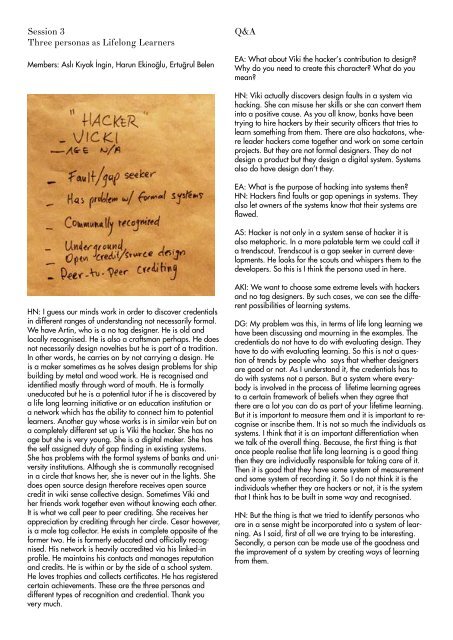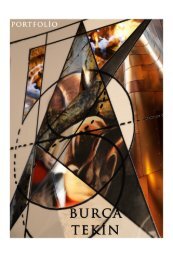BURCA TEKİN - 11535024 -
You also want an ePaper? Increase the reach of your titles
YUMPU automatically turns print PDFs into web optimized ePapers that Google loves.
Session 3<br />
Three personas as Lifelong Learners<br />
Q&A<br />
ACTIONS<br />
Members: Aslı Kıyak İngin, Harun Ekinoğlu, Ertuğrul Belen<br />
HN: I guess our minds work in order to discover credentials<br />
in different ranges of understanding not necessarily formal.<br />
We have Artin, who is a no tag designer. He is old and<br />
locally recognised. He is also a craftsman perhaps. He does<br />
not necessarily design novelties but he is part of a tradition.<br />
In other words, he carries on by not carrying a design. He<br />
is a maker sometimes as he solves design problems for ship<br />
building by metal and wood work. He is recognised and<br />
identified mostly through word of mouth. He is formally<br />
uneducated but he is a potential tutor if he is discovered by<br />
a life long learning initiative or an education institution or<br />
a network which has the ability to connect him to potential<br />
learners. Another guy whose works is in similar vein but on<br />
a completely different set up is Viki the hacker. She has no<br />
age but she is very young. She is a digital maker. She has<br />
the self assigned duty of gap finding in existing systems.<br />
She has problems with the formal systems of banks and university<br />
institutions. Although she is communally recognised<br />
in a circle that knows her, she is never out in the lights. She<br />
does open source design therefore receives open source<br />
credit in wiki sense collective design. Sometimes Viki and<br />
her friends work together even without knowing each other.<br />
It is what we call peer to peer crediting. She receives her<br />
appreciation by crediting through her circle. Cesar however,<br />
is a male tag collector. He exists in complete opposite of the<br />
former two. He is formerly educated and officially recognised.<br />
His network is heavily accredited via his linked-in<br />
profile. He maintains his contacts and manages reputation<br />
and credits. He is within or by the side of a school system.<br />
He loves trophies and collects certificates. He has registered<br />
certain achievements. These are the three personas and<br />
different types of recognition and credential. Thank you<br />
very much.<br />
EA: What about Viki the hacker’s contribution to design?<br />
Why do you need to create this character? What do you<br />
mean?<br />
HN: Viki actually discovers design faults in a system via<br />
hacking. She can misuse her skills or she can convert them<br />
into a positive cause. As you all know, banks have been<br />
trying to hire hackers by their security officers that tries to<br />
learn something from them. There are also hackatons, where<br />
leader hackers come together and work on some certain<br />
projects. But they are not formal designers. They do not<br />
design a product but they design a digital system. Systems<br />
also do have design don’t they.<br />
EA: What is the purpose of hacking into systems then?<br />
HN: Hackers find faults or gap openings in systems. They<br />
also let owners of the systems know that their systems are<br />
flawed.<br />
AS: Hacker is not only in a system sense of hacker it is<br />
also metaphoric. In a more palatable term we could call it<br />
a trendscout. Trendscout is a gap seeker in current developments.<br />
He looks for the scouts and whispers them to the<br />
developers. So this is I think the persona used in here.<br />
AKI: We want to choose some extreme levels with hackers<br />
and no tag designers. By such cases, we can see the different<br />
possibilities of learning systems.<br />
DG: My problem was this, in terms of life long learning we<br />
have been discussing and mourning in the examples. The<br />
credentials do not have to do with evaluating design. They<br />
have to do with evaluating learning. So this is not a question<br />
of trends by people who says that whether designers<br />
are good or not. As I understand it, the credentials has to<br />
do with systems not a person. But a system where everybody<br />
is involved in the process of lifetime learning agrees<br />
to a certain framework of beliefs when they agree that<br />
there are a lot you can do as part of your lifetime learning.<br />
But it is important to measure them and it is important to recognise<br />
or inscribe them. It is not so much the individuals as<br />
systems. I think that it is an important differentiation when<br />
we talk of the overall thing. Because, the first thing is that<br />
once people realise that life long learning is a good thing<br />
then they are individually responsible for taking care of it.<br />
Then it is good that they have some system of measurement<br />
and some system of recording it. So I do not think it is the<br />
individuals whether they are hackers or not, it is the system<br />
that I think has to be built in some way and recognised.<br />
HN: But the thing is that we tried to identify personas who<br />
are in a sense might be incorporated into a system of learning.<br />
As I said, first of all we are trying to be interesting.<br />
Secondly, a person can be made use of the goodness and<br />
the improvement of a system by creating ways of learning<br />
from them.<br />
AS: In this case it is not really the factor but it is the peer to<br />
peer crediting that is the point. I think the group wants to do<br />
that there is a system where peer-to-peer validation is relevant.<br />
It is not necessarily formalised, standardised, codified<br />
system of values but it is the peer-to-peer recognition which is<br />
relevant for the success and coming of these people.<br />
Cihan Çankaya (CÇ): There is one more thing I would like<br />
to add about the hackers. The hacker idea is also changed<br />
nowadays because it is not just about codes and algorithms<br />
anymore. For example, there is this newly heard movement of<br />
makers that hacks into mechanical systems as they contribute<br />
the systems instead. So the hacking is not just an underground<br />
or a coding thing anymore but it is rather a design thing<br />
because making becomes designing. That is what I would like<br />
to add.<br />
HN: To turn David’s contribution, how would we relate that to<br />
lifelong learning? That is the main issue.<br />
CÇ: That is important because maker movement teaches<br />
about trial and error in the cases of lifelong learning.<br />
Cİ: Thank you for all the comments.<br />
Group Conclusion<br />
Lifelong Learning happens at any time, anyway. Credentials<br />
received vary from the very personal amongst peers – informal,<br />
yet delicately tuned by those who share the same<br />
language, to framed documents recognized by the general<br />
public – these could be trophies - or the space/attention given<br />
in mass media.<br />
Recognizing that certification schemes of the established<br />
educational institutions are not able to appropriately keep<br />
pace with developments in society and technology. Hence,<br />
the challenge for this group was to identify the gaps that are<br />
not covered by credentials as dispensed by formal systems.<br />
Credentials may be the result of successfully hacking accepted<br />
norms and values, producing highly personalized badges<br />
of recognition and trust that could be collected, augmented,<br />
traded for higher valuations, and exchanged in various denominations.<br />
Moderator: David Grossman<br />
Outline<br />
Lifelong Learning goes along with Evidence-based<br />
Education/Learning. Blueprints – that are made of new<br />
concepts – for new vocational formats should consider<br />
how project-driven learning within concrete use-cases<br />
can enhance the development of competences and<br />
produce meaningful credentials that help people join or<br />
build most fitting working environments.<br />
Relevant Questions<br />
• Where is the need for Lifelong Learning most<br />
evident?<br />
• How does project-driven learning impact the<br />
development of competences?<br />
• What engagements can foster and reward<br />
learning as context anchored experience?<br />
Group Summary<br />
The set of competences required by professional designers<br />
is varied and changes dynamically during their<br />
lifetime. To maintain relevance and provide effective<br />
service, designers must continuously upgrade knowledge<br />
and skills. Knowledge- and skill-base established in the<br />
formal studies period serves only as a foundation on<br />
which to expand.<br />
There are numerous opportunities for designers to<br />
continue learning – structured and unstructured, formal<br />
and informal, intended and unintended, recognized and<br />
unrecognized. These range from courses and formats<br />
that are offered by educational institutions and professional<br />
entities, to conferences, lectures, workshops, and<br />
also personal development efforts that can be highly<br />
individual.<br />
It is important to plant the seeds of lifelong learning in<br />
the minds of professionals at an early stage - as part of<br />
the formal study curriculum, and to make them recognize<br />
not only the need for ongoing learning, but also the<br />
readily available spectrum of learning opportunities. A<br />
system, best introduced and maintained by the professional<br />
community, that would measure, recognize, and<br />
record ongoing learning efforts can support such efforts,<br />
producing formal/informal credentials.






